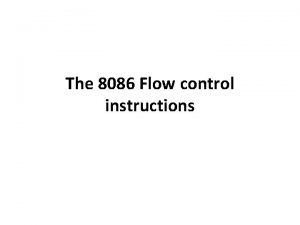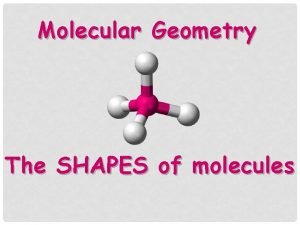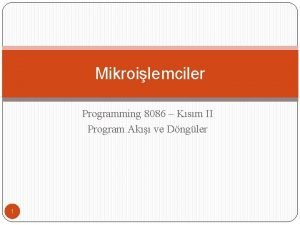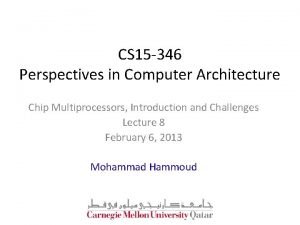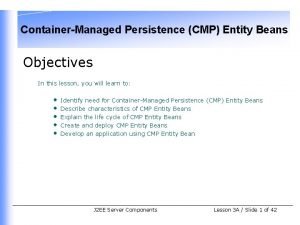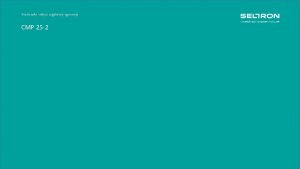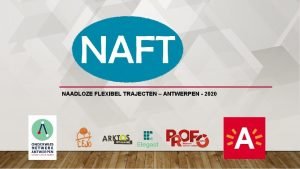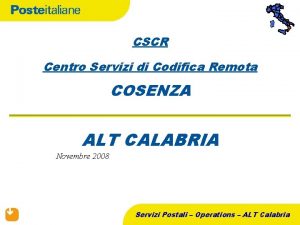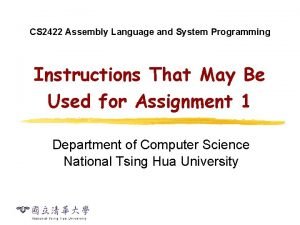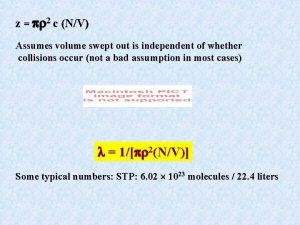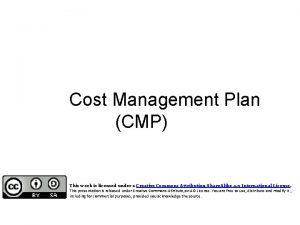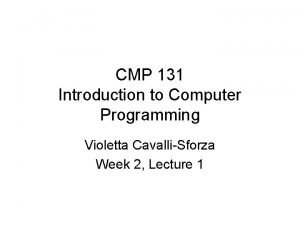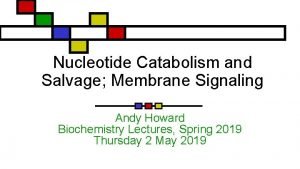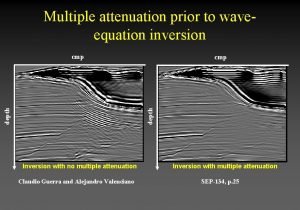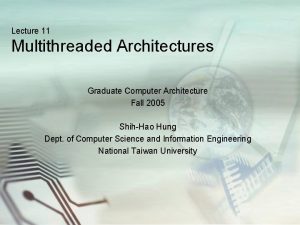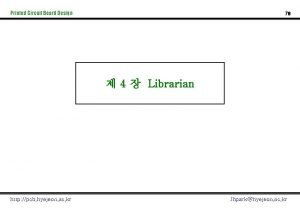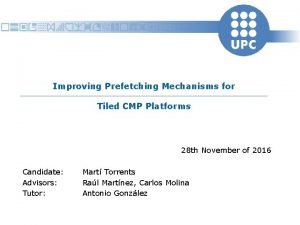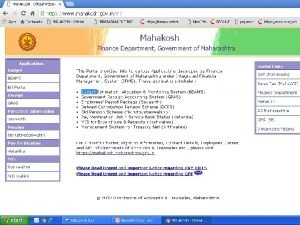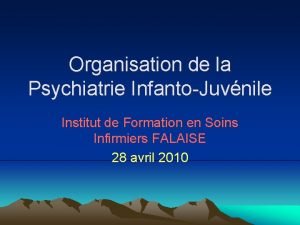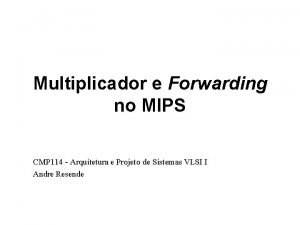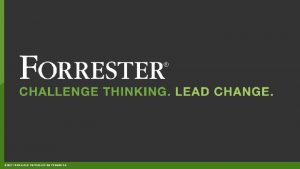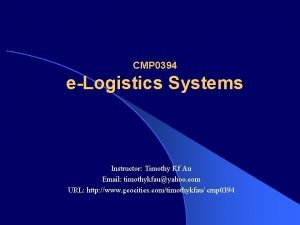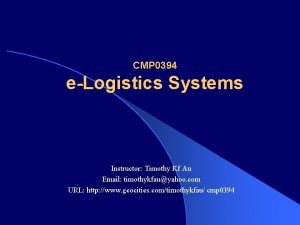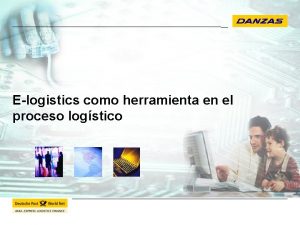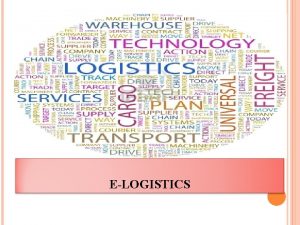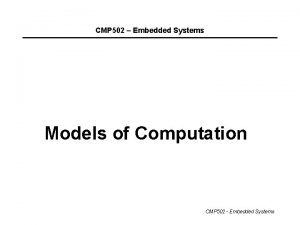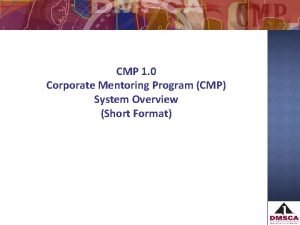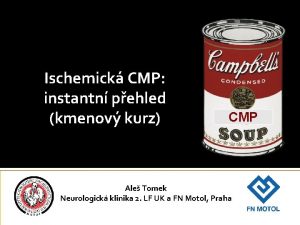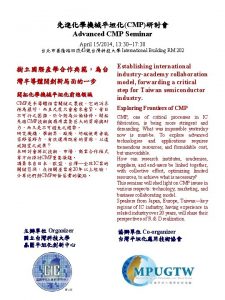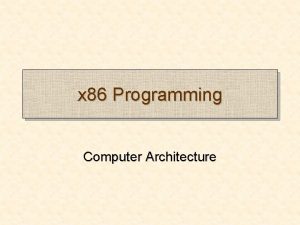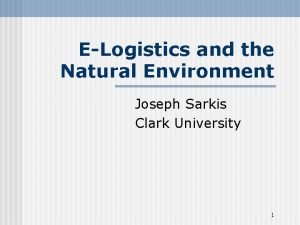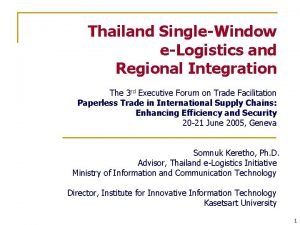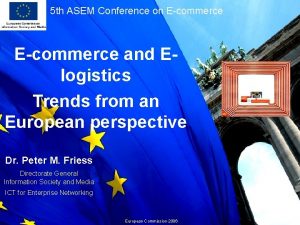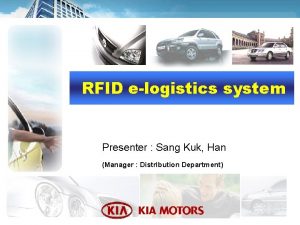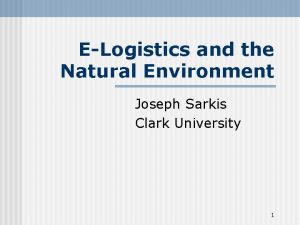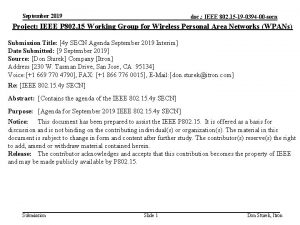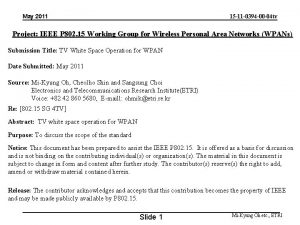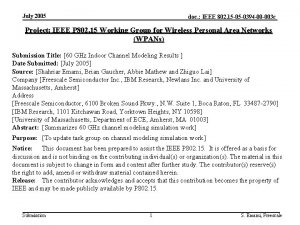CMP 0394 eLogistics Systems Instructor Timothy Kf Au
































- Slides: 32

CMP 0394 e-Logistics Systems Instructor: Timothy Kf Au Email: timothykfau@yahoo. com URL: http: //www. geocities. com/timothykfau/ cmp 0394

e-Business and e-Logistics Process Integration l l e-SCM Maturity Stages Supply Chain Order Execution Enabling Technologies Next Era B 2 B Platform 2

e-SCM Maturity Stages l e-SCM – is an e-business strategy l to ensure the right products, at the right time, at the right amount at the right place in the right condition at the right price with the right information. – involves a collaborative effect among trading partners l who have the strategic initiative to improve the physical flow, information flow and financial flow in a supply chain and to improve customer service and reduces costs. Data Managem ent Business Process Redesign Interenterprise systems Business Collaborat ion e-SCM Maturity Stages Integrated e-SCM 3

e-SCM Maturity Stages l e-SCM Roadmap – Enabling technologies l are essential to integrate physical flow, information flow and financial flow and the diversified business functions and to coordinate cross-functional activities across different organizational departments. – An efficient and accurate information flow l requires data capture at the points of goods receiving and dispatch are crucial to streamline internal processes as well as to collaborate with trading partners through information sharing and B 2 B data exchange. – Interorganizational information flow l Information flow is not limited to internal processes, there is a high demand in external connection, adoption of global standards in data management, data capture and data communications are in need to ensure “no barrier” data communications and data exchange without costly conversions and enabling timely deilvery of products and end customers and to bridge the “digitial-gap” between trading partners. 4

e-SCM Maturity Stages l e-SCM Maturity Stages 1. 2. 3. 4. Data Management Business Process Redesign Interenterprise Fusion Business Collaboration 5

e-SCM Maturity Stages 1. Data Management l l l Organize data in standardized electronic form EAN. UCC number RFID 6

e-SCM Maturity Stages 1. Data Management (continued) l EAN. UCC – – l Application Identifiers is a technique to include supplementary information such as “use by date”, quantities, batch numbers. Well structured and worldwide applicable data pool for storing associated information of each identification number. Benefits of EAN. UCC numbers – – Unique Key to access database and contains precise information. International standard rather than industrial standard. Secure for data capture – check digit. 7

e-SCM Maturity Stages 1. Data Management (continued) l EAN. UCC Barcode Standards – – – globally unique numbering system for identification of trade items and services – GTIN (Global Trade Item Number). number that identify functional or physical locations – GLN (Global Location Number) logistics units – SSCC (Serial Shipping Container Code) assets – GRAI (Global Returnable Asset Identifier); GIAI (Global Individual Asset Identifier) service relationship – GSRN (Global Service Relationship Number) 8

e-SCM Maturity Stages 1. Data Management (continued) l EAN. UCC automatic data capture – – – EAN-13, EAN-8, UPC-A, UPC-E, ITF-14 and UCC/EAN-128 RSS (Reduced Space Symbology) and EAN. UCC Composite Symbology 9

e-SCM Maturity Stages Data Management (continued) 1. – UCC/EAN-128 l The UCC/EAN-128 is the EAN/UCC endorsed technology to allows the encoding Application Identifier (AI) data which AI provides the techniques to add supplementary information such as batch number, serial number information in addition to identification numbers. 10

e-SCM Maturity Stages 1. Data Management (continued) l Automatic Identification (Auto. ID) – – Barcoding and symbologies Radio Frequency Identification (RFID) Biometrics e. g. eye, fingerprint, face, voice, hand, signature Magnetic strip 11

e-SCM Maturity Stages 1. Data Management (continued) l Radio Frequency Identification (RFID) – l Radio Frequency Identification uses radio wares to communicate information and the identity of an item carrying the data through the supply chain and to be dynamically and continuously updated. RFID is data carrier that complements to the EAN. UCC standards in many application areas: – – – Asset management for returnable transportation items such as containers Logistics process including tracking and tracing of items Electronic article control for anti-theft control 12

e-SCM Maturity Stages 1. Data Management (continued) l Advantages of RFID over bar coding in terms of distribution and order fulfilment: – – l Read multiple items at one time The ability to identify items without the “line of sight” RFID is most suitable for – – – high value products such as pharmaceuticals, electronics; high volume distribution centres where RFID can speed the goods receiving and shipping processing; better technology in “track and trace” applications where you can track goods through the supply chain including reverse logistics. 13

e-SCM Maturity Stages 2. Business Process Redesign l l Point-of-Sale data capture, inventory, warehouse management and ERP. Continuous planning and feedback 1. 2. 3. 4. Knowledge building and capacity evaluation – develop a clear vision of what customer needs are and a clear understanding of what capabilities you need. e-Business design – foundation to address new customer needs e-Business blueprint – create the mapping between the e-business design goals and the technologies based on your business model and your application framework. Application development and deployment – transform the projects into integrated applications and get feedback so that the plan can be refined. 14

e-SCM Maturity Stages 2. Business Process Redesign Top down strategic planning e-procurement Purchase Submit Order Supplier Fulfilment …. . Order Delivery e-fulfilment Order execution 15

e-SCM Maturity Stages 3. Interenterprise Fusion – – Purchase order, Shipping ordering, booking and invoicing using EDI/XML. Data communications in B 2 B Exchange l – XML has become the preferred technology in B 2 B exchange which is platform and software independent. Interoperability between EDI and XML l l A pilot test was conducted by HKANA in March 2001 in which the coexistence of both EANCOM® EDI and XML was proven. This is an important milestone to illustrate that the interoperability between EANCOM® EDI message and XML message without sacrificing the performance of data exchange activities. Because the flexibility, the scalability and the interoperability of XML, trading partner in supply chain no matter large corporates or SMEs can benefit from the centralized approach of document transaction, eliminating the cost of transaction due to multiple standards and different interfaces. 16

e-SCM Maturity Stages Interenterprise Fusion (continued) 3. Business Process Alignment – l l XML itself does not address the main problem of automated B 2 B communication which is how to align different business processes successfully and reliably. The international initiative, eb. XML run by the United National (UN/CEFACT) and OASIS aims to enable a global electronic marketplace where enterprises of any size and in any geographical location can meet and conduct business with each other Trading Party XML/EDI Trading Party e. Logistics Hub XML /EDI XML/EDI Trading Party Figure. XML/EDI Interoperability 17

e-SCM Maturity Stages 4. Business Collaboration l l Weapon of competitive advantages e. g. long term collaborative planning, continuous replenishment. 18

Supply Chain Order Execution l Supply Chain Order Execution – Elements of Supply Chain Execution l Order Planning Process l Production Process l Replenishment l Distribution management l Reverse logistics 19

Supply Chain Order Execution Forecasting Aggregate Inventory Planning Capacity Planning Replenishment Process MPS/Sourcing Order entry Order confir mation Fulfillment Planning Order Planning Process Inventory Availability – Schedule Production Allocate Inventory – Priority Orders Production Scheduling Distribution Scheduling Production Process Distribution Process Pick and Load Figure: Supply Chain Order Execution Schedule Home Delivery Customer Service 20

Supply Chain Order Execution l Purchasing versus Procurement – These two terms are often used interchangeably nowadays; but they differ in scope. – Difference between ‘Purchasing’ and ‘Procurement’: l l Purchasing refers to the actual buying of materials and those activities associated with the buying process. Procurement has a broader meaning and includes purchasing, transportation, warehousing and inbound receiving. Procurement begins with acquisition and ends with payment. 21

Supply Chain Order Execution l Why is procurement a top management concern? – PROCURMENT is evolving from a support function to a weapon of competitive advantages in a corporate. – COMPANIES are looking for solutions to high procurement costs, lengthy order cycle time and ensure smooth receipt and delivery of materials and services. – CHALLENGES l l l Reducing order processing costs and cycle time Provide enterprise-wide access to corporate procurement capabilities Empowering desktop requisitioning through self-service Achieving integration with back-office systems Elevating procurement to a position of strategic importance within the organization 22

Supply Chain Order Execution l e-Procurement Business Issue: Order Execution – Process Integration in Action …. . 2. Find suppliers 4. Order Items Web browser 5. Confirm order Multi-supplier catalog Catalog Order Form Availability Supplier 2 Supplier 1 Catalog Content Interchange 3. Find products 1. Product Catalog Supplier N Order Entry Approval Workflow PO Workflow 6. Transmit order, get confirmation 7. Order completed Fulfilment Shipment Accounting etc. 23

Supply Chain Order Execution l Selling Chain Management – Evolution of Selling Process l Drummer or peddler (Demand excess Supply) – Negotiate price and/or barter with customer l Salesman (Demand almost equals supply and limited competition) – high pressure selling; manipulative and canned; transaction oriented l Account Executives/Sales Consultant/Sales Engineer – build long term relationship; problem solving; adaptive selling l Relationship Manager (Partnering Value-Added Relationship Manager) – Synergistic relations with suppliers; real-time visibility into the process; customer needs are paramount. 24

Supply Chain Order Execution l Selling Chain Management – Selling Chain Process Complete Order Life Cycle Partial Functional Solutions to Order Life Cycle Integrated Selling Chain Solution Inquiry/ Prospect Customize Sales Lead Configurator Product Catalog Available to Promise Commit Contract Pricing Proposal & Quote Order Entry Commision Integrated Selling Chain Application Figure: Cross-functional Integrated Process – breaking down the departmental wall 25

Supply Chain Order Execution l e. Procurement Chain Create Requisition Approval Cycle Approved PO Supplier Fulfilment Select Product Route to Recipient Submit Order Ship Product Accounts Payable Receiving 26

Knowledge-tone Application Architecture l l To meet the challenge of creating an integrated decision framework, organizations have to implement a number of decision support applications under the framework of knowledge tone. The knowledge tone of architecture is built on a platform composed of THREE layers: 1. 2. 3. e-Business Solutions Enabling technologies Core technologies 27

Knowledge-tone Application Architecture E-BUSINESS SOLUTIONS ENABLING OLAP Customer Relationship Management TECHNOLOGIES HTML/XHTML XML/eb. XML Linux EDI Auto. ID UN/EDIFACT Unix CORE TECHNOLOGIES Networking Open Standards J 2 EE Messaging Security RAS RDBMS Billing & Payment Management Advertising / Promotion Management Data Mining Supply Chain SSL/TLS Management COM/DCOM/ DNA Knowledge Management COBRA/IIOP Performance Management Enterprise Resource Planning Figure. Enabling Technologies Architecture 28

Enabling Technologies l Enabling technologies – This layer includes the underlying technologies to support e-business applications, such as: – HTML/XTML – XML and eb. XML – EDI and UN/EDIFACT – Auto. ID (barcoding, RFID, Biometrics, Magnetic strips) – J 2 EE – SSL/TLS – CORBA/IIOP – COM/DNA 29

Next Era B 2 B Platform l Next Era B 2 B Platform e. Portal e. Service e-Business Application …. . Domain Specific Application Layer VAN Layer XML Layer (XML passer) 30

Next Era B 2 B Platform l Developing the e-Business Design – Moving Physical to Digital – The Challenge of E-Business Strategy Creation – Top-down Strategic Planning – Blueprint – Translating e-Business Strategy into Action 31

Thank you! Any Question? Instructor: Timothy Kf Au Email: timothykfau@yahoo. com URL: http: //www. geocities. com/timothykfau/ cmp 0394 32
 Cmp instruction 8086
Cmp instruction 8086 Shapes of molecules
Shapes of molecules Assembly cmp komutu
Assembly cmp komutu Cmp in computer architecture
Cmp in computer architecture Container managed persistence
Container managed persistence Metoda ścieżki krytycznej (cpm przykład)
Metoda ścieżki krytycznej (cpm przykład) Cmp 25
Cmp 25 Slidetodoc.com
Slidetodoc.com Centro smistamento poste lamezia terme
Centro smistamento poste lamezia terme Cmp instruction example
Cmp instruction example Cmp intel
Cmp intel Cmp:cavg:crms
Cmp:cavg:crms Cmp plan
Cmp plan Cmp programming
Cmp programming Bonding
Bonding Arm assembly ide
Arm assembly ide Cmp
Cmp Update cmp
Update cmp Cmp
Cmp Sun cmp architecture
Sun cmp architecture Cmp ipocinetica
Cmp ipocinetica Cmp
Cmp Cmp 공정 순서
Cmp 공정 순서 Cmp platforms
Cmp platforms Shalaarth
Shalaarth Cmp falaise
Cmp falaise Eforwarding
Eforwarding Forrester content marketing platforms
Forrester content marketing platforms Tipos de participantes en un grupo
Tipos de participantes en un grupo Tcole instructor course
Tcole instructor course Basic instructor course texas
Basic instructor course texas Basic instructor course texas
Basic instructor course texas Pepperball training manual
Pepperball training manual
